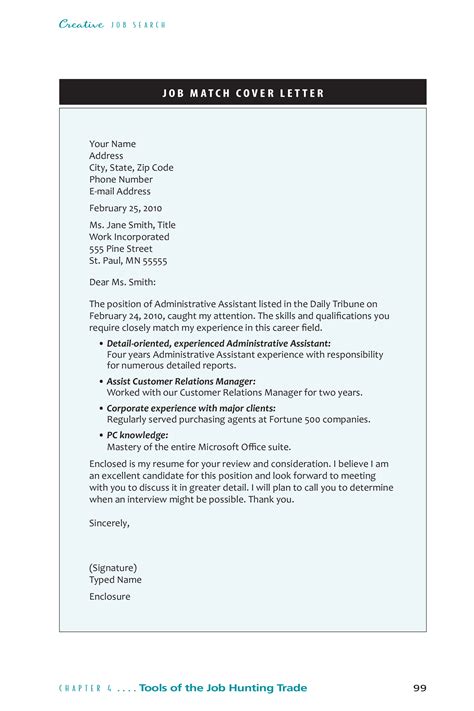Cover Letter Samples & Templates For Job Applications

When it comes to job applications, your cover letter can make all the difference. It’s the first thing a potential employer sees, and it’s your chance to make a good impression and stand out from the crowd. But how do you write a cover letter that gets noticed? In this post, we’ll provide you with tips, templates, and samples to help you create a killer cover letter that will land you your dream job.
1. The Importance of a Cover Letter
A cover letter is a crucial part of any job application. It’s a chance to introduce yourself, highlight your skills and experience, and explain why you’re the best candidate for the job. A well-written cover letter can help you stand out from other applicants and increase your chances of getting an interview.
Key Points:
- A cover letter is your chance to make a good first impression.
- It highlights your skills and experience.
- A well-written cover letter can increase your chances of getting an interview.
2. Types of Cover Letters
There are several types of cover letters, each with a different purpose. The most common types are:
- Application Cover Letter: This type of cover letter is used when you’re applying for a specific job.
- Networking Cover Letter: This type of cover letter is used when you’re reaching out to someone in your network for job leads or advice.
- Referral Cover Letter: This type of cover letter is used when you’ve been referred to a job by someone in your network.
Key Points:
- There are three types of cover letters: application, networking, and referral.
- Each type of cover letter has a different purpose.
3. Cover Letter Format
While there’s no one-size-fits-all cover letter format, there are some general guidelines you should follow:
- Header: Include your name, address, phone number, and email address at the top of your cover letter.
- Greeting: Address the hiring manager by name, if possible. If you don’t know their name, use “Dear Hiring Manager.”
- Introduction: Begin your cover letter with a strong opening that grabs the reader’s attention.
- Body: In the body of your cover letter, highlight your skills and experience and explain why you’re the best candidate for the job.
- Closing: End your cover letter with a strong closing that invites the employer to contact you.
- Signature: Sign your cover letter with your name and contact information.
Key Points:
- A cover letter should include a header, greeting, introduction, body, closing, and signature.
- Address the hiring manager by name, if possible.
- End your cover letter with a strong closing that invites the employer to contact you.
4. Cover Letter Templates
If you’re not sure where to start, there are plenty of cover letter templates available online to help you get started. Here are a few resources:
Key Points:
- There are plenty of cover letter templates available online to help you get started.
- Use a template as a starting point, but make sure to personalize it to fit your needs.
5. Cover Letter Samples
Looking for inspiration? Here are a few cover letter samples to help you get started:
Key Points:
- Looking at cover letter samples can help you get an idea of what to include in your own cover letter.
- Use samples as a starting point, but make sure to personalize your cover letter to fit your needs.
6. Common Mistakes to Avoid
When it comes to writing a cover letter, there are some common mistakes you should avoid:
- Not customizing your cover letter: Make sure to tailor your cover letter to the job you’re applying for.
- Using clichés: Avoid using overused phrases like “I’m a team player” or “I have excellent communication skills.”
- Being too formal: While you want to come across as professional, you don’t want to sound robotic. Use a conversational tone.
- Not proofreading: Make sure to proofread your cover letter carefully for spelling and grammar errors.
Key Points:
- Avoid common mistakes like not customizing your cover letter, using clichés, being too formal, and not proofreading.
- Make sure to proofread your cover letter carefully for errors.
7. Conclusion
A well-written cover letter can make all the difference when it comes to landing your dream job. By following these tips, templates, and samples, you’ll be well on your way to creating a killer cover letter that will get you noticed by potential employers.
FAQs
What should be included in a cover letter?
A cover letter should include a header with your name, address, phone number, and email address; a greeting addressed to the hiring manager; an introduction that grabs the reader’s attention; a body that highlights your skills and experience; a closing that invites the employer to contact you; and a signature with your name and contact information.
How long should a cover letter be?
A cover letter should be one page or less.
Should I include my salary requirements in my cover letter?
No, it’s not necessary to include your salary requirements in your cover letter unless the employer specifically asks for them.
How do I address a cover letter if I don’t know the hiring manager’s name?
If you don’t know the hiring manager’s name, you can use “Dear Hiring Manager” or “To Whom It May Concern.”
Can I use a cover letter template?
Yes, there are plenty of cover letter templates available online to help you get started. However, make sure to personalize the template to fit your needs.
What are some common mistakes to avoid when writing a cover letter?
Common mistakes to avoid include not customizing your cover letter, using clichés, being too formal, and not proofreading.
